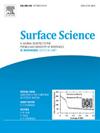First-principles analysis of mechanical, optoelectronics and piezoelectric properties in buckled honeycomb GeSe monolayer
IF 1.8
4区 化学
Q3 CHEMISTRY, PHYSICAL
引用次数: 0
Abstract
Our study systematically investigates the mechanical, optoelectronics, and piezoelectric properties of the buckled honeycomb GeSe monolayer (BH-GeSe) using first-principles theory. The stability of the BH-GeSe monolayer is confirmed through phonon dispersion, thermal stability, binding energy, and elastic constant analyses. Its small Young's modulus of 31.05 N/m imparts exceptional flexibility, with an ideal stress (σbia) of 6.2 N/m and a high fracture strain (εbia) of 0.2. The optoelectronic properties are analyzed through energy band structures and light absorption spectra. The BH-GeSe monolayer is identified as an indirect semiconductor with a energy band gap of 2.95 eV at equilibrium. Biaxial strain induces notable changes in the conduction band minimum (CBM), valence band maximum (VBM), and an energy band gap. Specifically, the energy band gap decreases by up to 51 % under strain. Light absorption coefficients and energy-loss spectra are significantly enhanced, particularly in the infrared and ultraviolet regions, showcasing its superior optical properties. Piezoelectric coefficients are derived from polarization variations in clamped-ion and relaxed-ion states. The piezoelectric coefficients d11 and d31 are calculated as 11.85 pm/V and −0.71 pm/V, respectively, indicating a robust piezoelectric response that surpasses many well-studied two-dimensional materials. These results highlight the BH-GeSe monolayer as a promising material for next-generation optoelectronic and piezoelectric devices. Outstanding flexibility, strain-tunable electronic properties, and strong piezoelectric response position the BH-GeSe monolayer as a leading candidate for diverse applications in advanced material science.

屈曲蜂窝GeSe单层材料力学、光电和压电性能的第一性原理分析
本研究利用第一性原理理论系统地研究了屈曲蜂窝GeSe单层(BH-GeSe)的机械、光电和压电性能。通过声子色散、热稳定性、结合能和弹性常数分析证实了BH-GeSe单层膜的稳定性。其31.05 N/m的小杨氏模量赋予了优异的柔韧性,理想应力(σbia)为6.2 N/m,断裂应变(εbia)为0.2。通过能带结构和光吸收光谱分析其光电性能。BH-GeSe单层被确定为间接半导体,平衡能带隙为2.95 eV。双轴应变引起导带最小值(CBM)、价带最大值(VBM)和能带间隙的显著变化。具体来说,在应变作用下,能带隙减少了51%。光吸收系数和能量损失光谱显著增强,特别是在红外和紫外区域,显示出其优越的光学性能。压电系数由箝位离子和弛豫离子状态下的极化变化得到。压电系数d11和d31的计算值分别为11.85 pm/V和- 0.71 pm/V,表明压电响应的鲁棒性超过了许多得到充分研究的二维材料。这些结果突出了BH-GeSe单层材料作为下一代光电和压电器件的前景。突出的灵活性,应变可调的电子性能和强大的压电响应使BH-GeSe单层成为先进材料科学中各种应用的主要候选材料。
本文章由计算机程序翻译,如有差异,请以英文原文为准。
求助全文
约1分钟内获得全文
求助全文
来源期刊

Surface Science
化学-物理:凝聚态物理
CiteScore
3.30
自引率
5.30%
发文量
137
审稿时长
25 days
期刊介绍:
Surface Science is devoted to elucidating the fundamental aspects of chemistry and physics occurring at a wide range of surfaces and interfaces and to disseminating this knowledge fast. The journal welcomes a broad spectrum of topics, including but not limited to:
• model systems (e.g. in Ultra High Vacuum) under well-controlled reactive conditions
• nanoscale science and engineering, including manipulation of matter at the atomic/molecular scale and assembly phenomena
• reactivity of surfaces as related to various applied areas including heterogeneous catalysis, chemistry at electrified interfaces, and semiconductors functionalization
• phenomena at interfaces relevant to energy storage and conversion, and fuels production and utilization
• surface reactivity for environmental protection and pollution remediation
• interactions at surfaces of soft matter, including polymers and biomaterials.
Both experimental and theoretical work, including modeling, is within the scope of the journal. Work published in Surface Science reaches a wide readership, from chemistry and physics to biology and materials science and engineering, providing an excellent forum for cross-fertilization of ideas and broad dissemination of scientific discoveries.
 求助内容:
求助内容: 应助结果提醒方式:
应助结果提醒方式:


